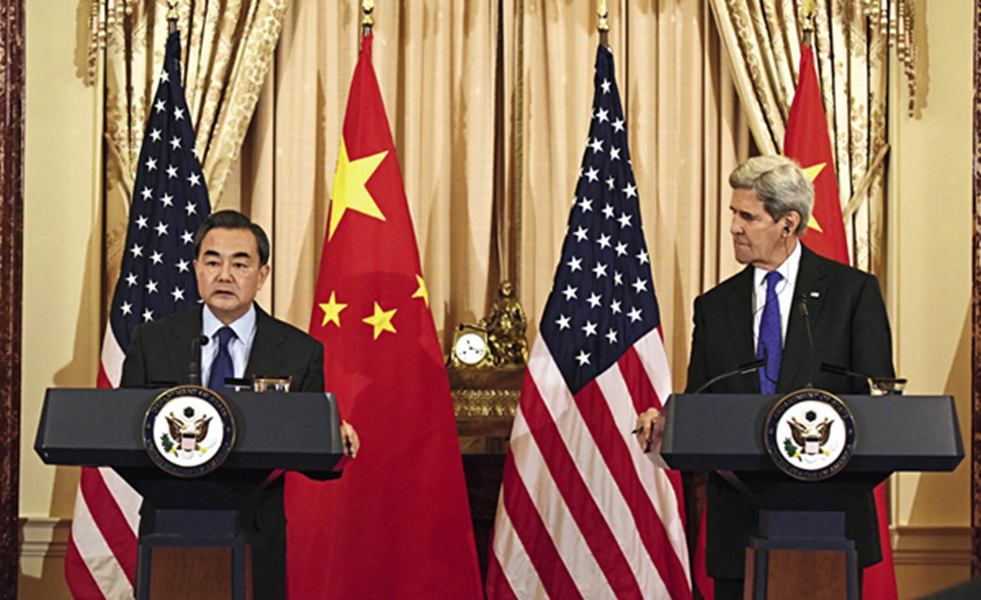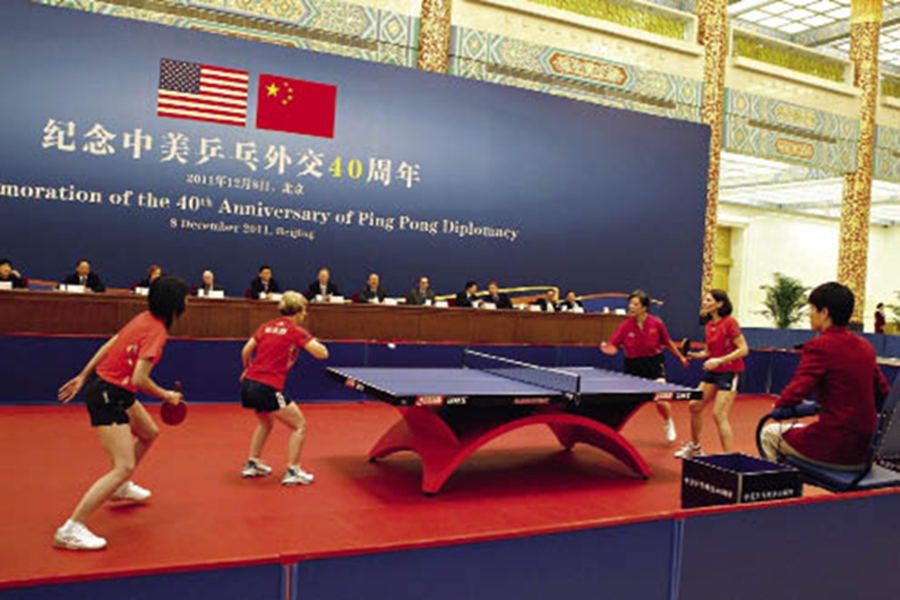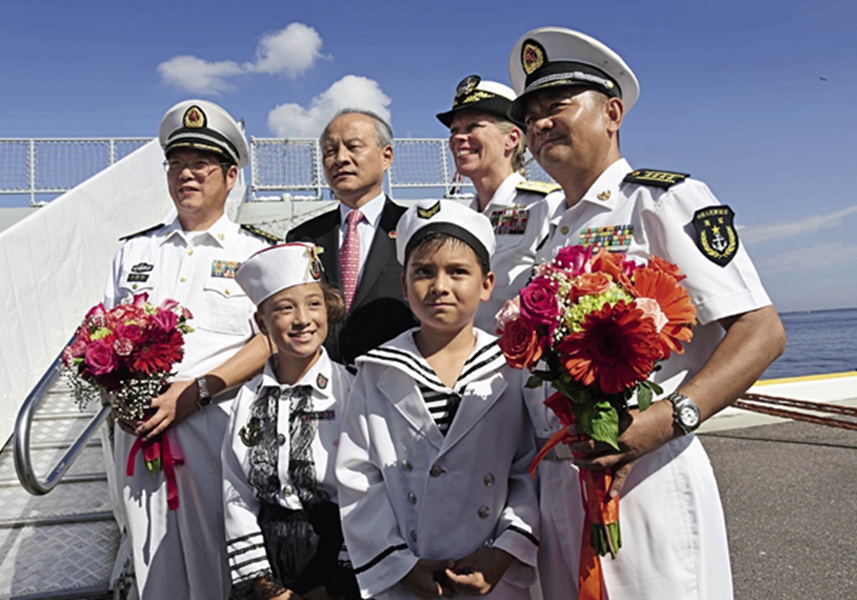By ZHANG WENZONG
By ZHANG WENZONG
ENTERING 2016, President Obama embarked on his last year in office, and the presidential election campaign hit its home strait. According to media polls, the issues of greatest concern to Americans include the domestic economic situation, the two parties’ presidential nominees, the possibility of the country becoming the victim of another terrorist attack, and the complete defeat of ISIS.

Chinese Foreign Minister Wang Yi and U.S. Secretary of State John Kerry at a joint press conference held in Washington D.C. during Wang’s official visit to the U.S. that began on February 23, 2016.
In China, the complex economic situation, sluggish stock market, and the Renminbi’s fluctuating exchange rates riveted people’s attention on the domestic economy, the anti-corruption campaign, the situation in the Middle East, and the prospects for the Belt and Road Initiative.
However, North Korea’s fourth nuclear test and its ensuing satellite launch set off a ripple effect in Northeast Asian politics. They also add new elements to the China-U.S. relationship. The two massive countries and their historical interaction on questions surrounding the Asia-Pacific and other global issues will exert significant influence on the economies and the welfare of the two peoples, as well as the Middle Eastern situation and Asia-Pacific security. The bilateral relationship in this new era will demand a heightened sense of priorities, and painstaking efforts from both sides.
A Tree Craves Calm While the Wind Wails
In April, 45 years ago, “ping-pong diplomacy” ended 20-plus years of estrangement and antagonism between China and the U.S., thus marking the thawing of bilateral relations. The next year, President Nixon visited China. This visit culminated in issue of the first joint communiqué – the Shanghai Communiqué – declaring normalization of bilateral relations. The two countries established formal diplomatic relations on January 1, 1979, ending a 30-year-long deadlock.
The past 45 years have witnessed ebbs and flows in these relations, with tentative moves, contacts, handshakes, and embraces, but also moments of disappointment, suspicion, rhetoric, and resentment. Particularly after the 2008 financial crisis erupted and the U.S. implemented its “rebalancing” strategy in the Asia-Pacific region, bilateral relations have undergone a gradual deterioration – economic and trade frictions, the South China Sea issue, disputes over the Diaoyu Islands, network security, and jockeying over the Trans-Pacific Partnership Agreement (TPP) and Asian Infrastructure Investment Bank (AIIB) – all have kept the two countries’ decision-makers busy. The bilateral relationship remains stable in general, but heated arguments and confrontation have palpably increased.

“Ping-pong diplomacy” is the well-known gambit in China-U.S. relations. The picture shows a ceremony in 2011 in Beijing commemorating its 40th anniversary.
From a historical perspective, relations between China and the United States have undergone a sea change. Their common interests in a slew of major issues such as countering the former Soviet Union, globalization, anti-terrorism, and tackling the global financial crisis have yielded to long-simmering and also recent disputes, one embodiment thereof being the contradiction between a superpower and a rising nation. China longs for rejuvenation, while the U.S. frets over the loss of its global leadership. China wants to build a new model of major-country relations with the U.S., setting a strategic long-term framework for the two countries. The U.S. remains wary of China’s intentions, declining any compromise on high priority issues of particular concern to China. In 2015, American politicians touched off a round of debates on policy toward China. Hardliners, centrists, and advocates of current policies held differing points of view, but all conceded that the ranks of domestic groups supporting development of relations with China have thinned, even as in China the view has become more prevalent that the U.S. is encircling and containing the PRC.
Without control and management of Sino-U.S. strategic relations and specific issues, the political logic of competition between major countries will push the two countries on the path of confrontation. To safeguard national interests and the stability of the bilateral relationship, high-level leaders from the two countries have maintained close communications and strenuous political efforts. One example is President Xi’s successful state visit to the U.S. last September. The two countries have since implemented effective cooperation in the fields of competition alleviation in global economic governance, building a mutual-trust military mechanism, jointly combating cybercrime, and expanding cultural exchanges. All of these have effectively arrested the downward trend in bilateral relations.

The 20th Chinese navy escort fleet arrives at Naval Station Mayport, a major U.S. Navy base located near Jacksonville in Florida, on November 3, 2015.
However, efforts from top leaders hardly serve to bridge differences. Shortly after Xi’s visit, the U.S. initiated military provocations in the South China Sea by sending a naval vessel to the inshore waters of Zhubi Reef, and a B-52 bomber was sent to trespass within the airspace of the 12-nautical mile limit surrounding the Huayang Reef, while last January a navy vessel sailed past Zhongjian Island (one of the Xisha Islands) thereby severely undermining China’s sovereignty and territorial security. Just before the election of Taiwan’s new leader, the U.S. declared a new round of arms sales to Taiwan worth US $1.83 billion. After the election, former Deputy Secretary of State William Burns visited Taiwan for the purpose of laying the foundation for U.S.-Taiwan relations after Tsai Ing-wen’s assumption of office. China and the U.S. are thus locked in a contest over issues concerning China’s territory and sovereignty. As the old saying goes, “A tree craves calm while the wind wails.”
Transform a Crisis into an Opportunity
China is striving to build a moderately prosperous society and a modern socialist country. It desires stability in Sino-U.S. relations and in its surrounding environment. However, the rise of China and the American rebalancing strategy in the Asia-Pacific have changed China’s ambient environs. As the U.S. applies strategic pressure on China, leveraged by its rising national strength and influence, China has become correspondingly more proactive in diplomacy. Several new features in the interaction between China and the U.S. have become evident as a result.
First, the two countries have attained breakthroughs in military relations, though competition still persists. The Chinese military’s modernization and enhancement of its anti-access/area-denial (A2/AD) ability is closely bound up with American implementation of the U.S. army’s Joint Operational Access Concept (JOAC) and the third “offset strategy.” The U.S. has pledged to deploy 60 percent of its naval and air forces to the Asia-Pacific, and to harden its system of alliances and partnerships. This was an important factor in inducing China to establish the air defense identification zone in the East China Sea, and accelerating the pace of land reclamation projects on atolls and other islands in the South China Sea. China’s moves have goaded the U.S. into conducting more frequent freedom of navigation exercises. These, in turn, have spurred China to deploy surface-to-air missiles on Yongxing Island. To manage crises such as accidental discharges or conflicts, high-level officials have supported the establishment of closer ties between the two militaries in recent years. Reciprocal visits among high-level officers and naval vessels, and joint operations by naval and air forces, especially the establishment of the confidence-building measures (CBM) for the notification of major military activities, and the rules of conduct for safety of air and maritime encounters, are instrumental in averting misunderstandings and miscalculations between the two forces.
Second, geopolitical and geoeconomic competition between China and the U.S. has intensified, but leeway remains for both. The U.S. and Japan have revised the historical Guidelines for U.S.-Japan Defense Cooperation. The U.S. has also secured the right to use eight military bases in the Philippines, while trilateral and quadrilateral military relationships have swiftly developed, for example, the U.S.-Japan-the Philippines, the U.S.-Japan-India, the U.S.-Japan-Australia, and the U.S.-Japan-Australia-India, all of which imply the resurgence of a “little NATO” in the Asia-Pacific. At the same time, China has reinforced its strategic cooperative partnership with Russia. Both have conducted effective cooperation under the Shanghai Cooperation Organization and within the framework of the BRICS mechanism, and inked agreements in the fields of energy and military industry. They also manifested a tacit understanding by celebrating the 70th anniversary of the Anti-Fascist War and World War II.
As the U.S.-led TPP reached agreement and the Trans-Atlantic Trade and Investment Partnership Agreement (TTIP) advanced, the Belt and Road Initiative proposed by China and the Regional Comprehensive Economic Partnership (RCEP) it also advocates have made further headway. The “quasi-group” in global politics has seemingly driven China and the U.S. farther in different directions. However, neither are likely to see the confrontation à la the two camps in the Cold War reprised. China emphasizes the non-alliance form of the China-Russia relationship. It has invited the U.S. to join the AIIB on several occasions. In the U.S., views differ on whether China should be invited to the TTP.
Third, the contest over global issues has objectively improved the structure of global governance. Compared to competition in military matters and geopolitics, the cooperation atmosphere in global issues is evincing a stronger momentum. China boosted the establishment of the AIIB, prompting the U.S. Congress to approve the IMF’s reform plans for quotas and governance for the year 2010. As the quotas of emerging economies like BRICS countries have increased, the reform improved the IMF’s representativeness and legitimacy, as well as its governance capacity. Hacker attacks on the Federal Office of Personnel Management (OPM) database provided an opportunity for China and the U.S. to resolve disputes over network security. Both countries pledged to work together to combat cybercrime, including establishing a hotline mechanism, and reaching consensus on a broad spectrum from specific cases, to anti-terrorism cooperation, to law enforcement training. As the world’s two leading countries in the Internet field, their cooperation will be conducive to improving global Internet governance. The two countries formerly disputed climate change issues at the 2009 Copenhagen Conference. However, after several years of negotiations and preparation, both have changed their pre-existing stances, and the contributions of each at the Paris Conference in December 2015 were critical to achieving consensus. Jointly, they were able to persuade all countries attending to sign the “Paris Agreement” and defined the direction and goals for post-2020 global cooperation to address this threat. China and the U.S. have also facilitated attainment of the joint comprehensive plan of action between Iran and six relevant countries on the Iranian nuclear issue, thus discharging an indispensable function in upholding regional stability in the Middle East and bolstering non-proliferation mechanisms.
New Way of Getting Along
The question looms large of whether in future China and the U.S. will gradually drift apart and become estranged, or instead devise a new means of getting along despite frictions. The conclusion seems to be that neither may dispense with the other. This is a major issue implicating world peace and development. Pessimists deem humans unable to resist the ineluctable rule that an emergent power is bound to challenge an incumbent hegemony, and that the two countries will inevitably proceed towards confrontation and conflict. Optimists, however, believe people are able to learn from past experience and lessons, and thus avoid historical mistakes. Mainstream politicians and social elites in both countries stand between these two poles. Witnessing and creating history, they are conscious that they shoulder a special responsibility. They should manage the bilateral relationship with prudence and an optimistic attitude, and guide people to think and judge rationally without blind reaction.
First, the two countries must adhere to a baseline precept of no-confrontation and no-conflict, and convene arms control negotiations when conditions ripen. The spiral of arms race and confrontation will otherwise devour the wealth of both countries long-term, resulting in the exhaustion of one or both parties, or even trigger an armed conflict. The construction of a mutual-trust military mechanism remains a primary tool of managing and averting crises, but this alone cannot resolve the strategic hostility and security dilemmas the two countries confront. In light of the great disparity between China and the U.S. and its allies in military power, the U.S. needs to understand the necessity for and urgency of China’s military modernization. When military power is more balanced, it will be possible for the two armed forces to consider building more mutual trust mechanisms in such fields as nuclear weapons and the Internet and, as the U.S. and the Soviet Union did before, engage in negotiations on the R&D and deployment of conventional and nuclear weapons and reach a binding agreement thereon.
Second, the two countries must maintain strategic prudence in major issues on which they have obvious differences, so as to prevent chaos from overwhelming the overall bilateral relationship. It will otherwise be difficult to reach a framework agreement on bilateral relations. However, the two countries can communicate on bottom-line principles and engage in strategic placation of each other in terms of core interests and major concerns. For example, after the DPP takes office in Taiwan, the U.S. should avoid “enabling” Taiwan when implementing its rebalancing strategy in the Asia-Pacific region, so as not to undermine the political foundations of the China-U.S. relationship. For China’s part, when safeguarding its sovereignty in the South China Sea, it must respect U.S. freedom of navigation in international waters, and show tolerance, to a certain degree, of the scouting actions of American warships. With the Korean Peninsula, the stability there upon which China insists and the denuclearization that is a high U.S. priority can advance in tandem. China and the U.S. can consider restarting the six-party talks and constructing a Northeast Asia peace mechanism during the process of denuclearization.
Third, the two countries should promote economic cooperation and cultural exchanges, thereby setting the bilateral relationship on a solid footing. Any exclusive trade and investment arrangement will eventually constrain the bilateral economic and political relationship. Therefore, both sides must promote from a strategic vantage the building of an Asia-Pacific free trade zone or an Asia-Pacific economic community, in addition to existing bilateral investment treaties (BIT) negotiations, and expand trade and technical cooperation in environmental and new energy products. The two nations must promote activities in the “China-U.S. Tourism Year” falling this year, boosting student exchanges and cooperation in arts, sports and health. People-to-people exchanges and understanding are an empirical pedagogy for both peoples, conducive to nurturing moderation and reasonable voices, while resisting the clamor of populist inclinations.
Against the backdrop of the U.S. presidential election now in full swing, it is unrealistic to expect the two countries to reach compromises on a raft of major issues. Only when the two nations truly emerge from the 2008 financial crisis and are able to smoothly boost domestic reforms and development will it be possible for decision-makers to view common points and differences in a more detached way, and manage the bilateral relationship with greater confidence. Prior to that, I hope the two countries may rein in their competition in geopolitics, input more energy and resources into global governance, and prudently deal with sensitive issues to maintain a sound bilateral relationship for future development.
ZHANG WENZONG is an associate research fellow at the Institute of American Studies, China Institute of Contemporary International Relations.